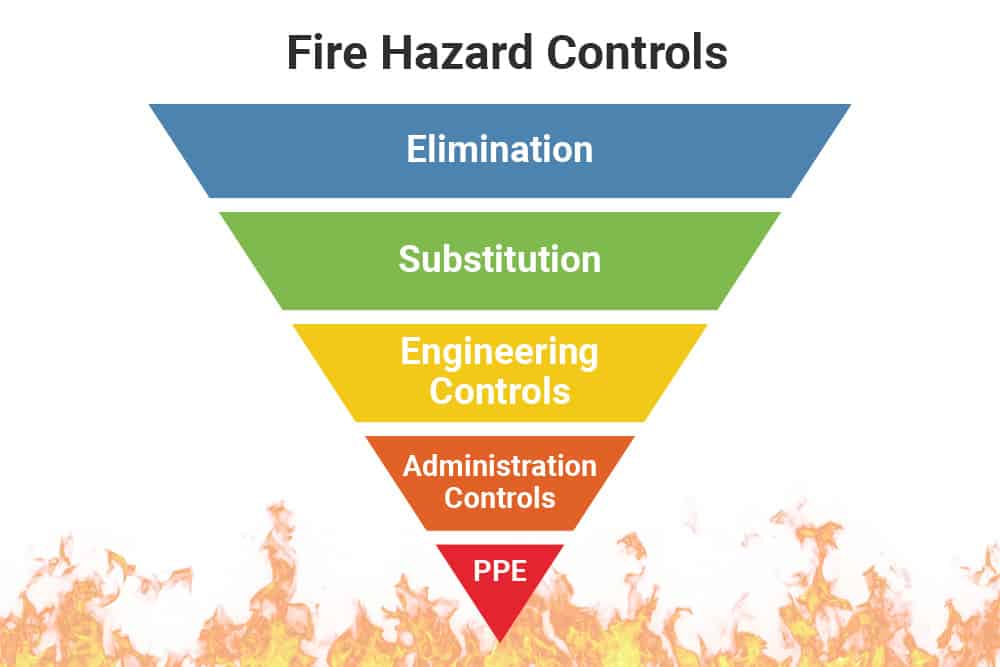
Knowing exactly how to perform a fire safety risk assessment is a critical part of fire prevention and a legal requirement under the Regulatory Reform (Fire Safety) Order 2005 (FSO). Every UK workplace should conduct a fire safety assessment on a regular basis.
This blog will provide you with the key information you need to know to conduct your own fire safety risk assessment. It can also be used to devise an effective fire safety risk assessment template for your place of business so anyone can conduct one.
How many steps make up a fire safety risk assessment?
There are five major steps involved in conducting a fire safety risk assessment:
- Identify any potential fire hazards
- Identify any people that may be at risk
- Evaluate the severity of the risks and act to remove or reduce them
- Record all findings, develop an emergency plan, initiate training
- Regularly review and update your fire safety risk assessment
1. Identify fire hazards
Look for sources of ignition
Start off by looking for all the potential sources of ignition. These may include:
- Flames or sparks from a work process, such as grinding, welding or soldering
- Electrical equipment, such as ovens and cooking equipment such as heaters (particularly those that provide radiant heat),
- Kilns, incinerators and boilers that create hot surfaces
- Matches or lighters either as part of a legitimate work process or by smokers
All forms of electrical equipment can be a source of ignition if they are faulty or being misused. Examples of this can include overloaded electrical circuits or faulty, damaged or obsolete wiring within the premises. Frictional heat may be caused by a work process, faulty equipment or electrostatic discharges.
When identifying sources of ignition, it is important to think about the occasional situations that may cause fires. For example, when contractors come onto the premises to carry out maintenance or repairs.
Look for combustible materials
Next, your assessment must identify all the main sources of combustible materials. There are three areas to consider:
Firstly, combustible materials or fluids that you use as part of your operations. These may include:
- Large quantities of paper, including files and folders
- Timber products
- Packaging materials
- Flammable liquids, such as cooking oils, paints and cleaning products
- Flammable gases and cylinders
Secondly, you should assess all furniture and furnishings. All new furniture should now comply with fire safety legislation and should not readily burn. You can check this via product labels.
Older furniture, bought before 1988, may not comply and should be checked. Other furnishing items, such as curtains, are not subject to fire safety legislation and will need to be considered carefully.
The third area to look at is the structure of the premises, including fittings. Older buildings are sometimes constructed from combustible materials that increase the fire risk significantly. Modern buildings are usually constructed from steel concrete and brick.
There is often a wide range of materials that will readily burn, even if the main structure may not.
These include:
- Combustible ceiling and wall linings
- Partition walls, that are either combustible or use insulation, or other combustible materials
- Noticeboards
- Timber shelving
- Combustible glazing
Look for Sources of Oxygen
The final aspect of the hazard identification exercise is to consider structural features in the premises that can feed a fire with oxygen or allow a fire to spread. These include unprotected openings in compartment walls, ceilings and flooring including voids at the rear of wall panels or above compartment ceilings.
You should also look out for doors that do not close properly and stairways that form an open shaft through which a fire can spread rapidly.
2. Identify people at risk
Although every person on or near the premises is at risk if there is a fire, some workers may be more at risk than others. Lone workers, pregnant women, children, the elderly or disabled people can be at greater risk if a fire breaks out.
3. Evaluate the severity of the risks and act
The data gathered should be then carefully assessed to determine the exact risks of a fire starting and what can be done to remove or reduce these risks.
To control fire hazards, you can act to:
- Eliminate the hazard – For example, remove sources of ignition or flammable materials and use flame retardant materials or non-flammable substances
- Reduce the hazard – Provide fire-resistant walls or breaks that can contain the spread of fire
- Prevent contact with the hazard – Store combustible or flammable materials or rubbish in fire-resistant containers
- Implement safe systems of work – Ensure high standards of housekeeping, including the cleanliness of the fabric of the premises, as well as the build-up of dirt, grease or other flammable wastes
- Protective equipment – Provide suitable signage, fire alarms, firefighting equipment and extinguishers and ensure they are visible and operable

4. Record findings, develop an emergency plan, initiate training
Ensure that a detailed record of the fire safety risk assessment is kept both on paper and in digital format. All findings should be recorded as well as any measures taken to reduce or eliminate fire risks.
An emergency plan should be devised that outlines emergency procedures (such as firefighting techniques as well as contacting and collaborating with emergency services), emergency exit routes (taking into consideration any vulnerable or at-risk persons), and an evacuation muster point.
All staff need to know what to do in case a fire breaks out. Regular training on emergency fire procedures should be undertaken so staff know their roles and responsibilities.
5. Review and update your fire safety risk assessment
The last step is to ensure that your fire safety risk assessment is regularly reviewed and updated. No workplace environment remains static. Changes to the workplace environment or to your work practices can result in increased fire risks.
Even if no obvious workplace changes have occurred, it is a good idea to review your fire safety risk assessment on a quarterly basis.
Online fire safety risk assessment training
A fire safety risk assessment must be carried out by a ‘responsible person’, according to the FSO and the Health and Safety Executive (HSE). The ‘responsible person’ can be an employer or a competent person appointed by the employer. Sufficient training will ensure that a ‘responsible person’ is capable of conducting a fire safety risk assessment. A fire safety checklist can be used to do daily, weekly or month fire safety checks.
Human Focus offers accredited, certified online fire safety risk assessment training. Participants who complete a Fire Risk Assessment Training course will gain in-depth, relevant knowledge of how to identify, evaluate and reduce or remove fire risks in the workplace. This course is approved by the International Institute of Risk & Safety Management (IIRSM) and is suitable for staff members at any level of an organisation.




























































































































































































































































































































































































































































































































































































































































































































































